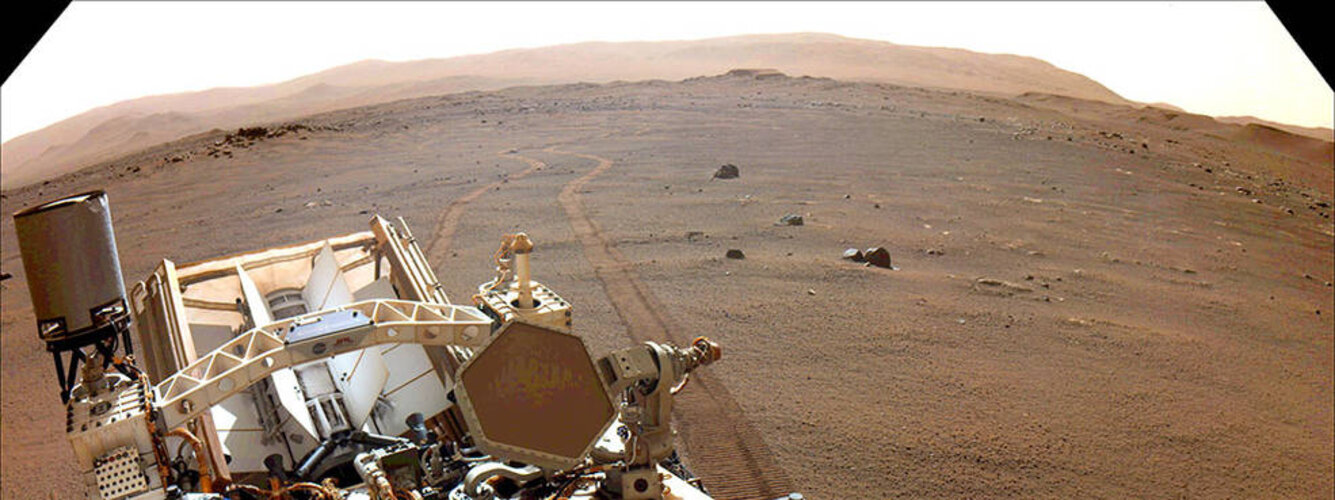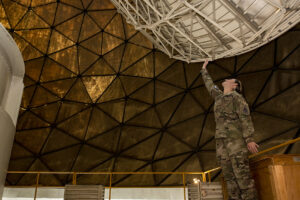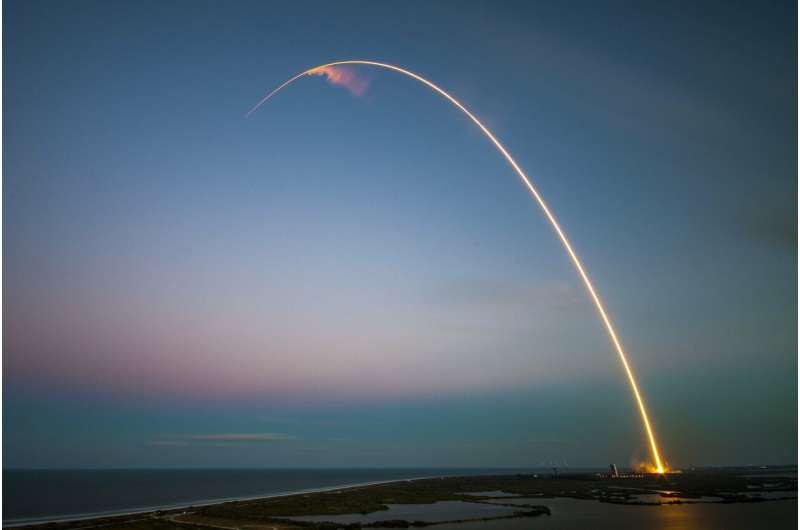Earth from Space: Svalbard
Friday, 28 October 2022 07:00
Extremely high temperatures recorded this summer caused record melting across Svalbard – one of the fastest warming places on the planet. The Copernicus Sentinel-2 mission captured this rare, cloud-free acquisition of the Norwegian archipelago in August 2022.
Scientists choose first Mars samples worthy of return to Earth
Friday, 28 October 2022 05:40
The first samples to be taken from Mars and sent to Earth will be sourced from Jezero Crater, where the Perseverance rover has been exploring the crater floor and nearby ancient delta. The location of an initial cache of samples, called Three Forks, is flat and free of obstacles – an ideal spot for a Mars Sample Return landing and pickup operations.
Major Gomspace satellite customer withholding payments
Friday, 28 October 2022 01:14
Gomspace delayed the release of financial results Oct. 27 as the European smallsat maker tries to get a major commercial customer to pay its bills.
The post Major Gomspace satellite customer withholding payments appeared first on SpaceNews.
Russia escalates rhetoric on commercial satellites, calls them ‘legitimate targets for retaliation’
Thursday, 27 October 2022 21:04
A Russian official said at a UN meeting that commercial space systems "may become a legitimate target for retaliation.”
The post Russia escalates rhetoric on commercial satellites, calls them ‘legitimate targets for retaliation’ appeared first on SpaceNews.
U.S. national defense strategy calls for ‘resilient, redundant’ space networks
Thursday, 27 October 2022 19:43
The unclassified version of the U.S. national defense strategy released by the Defense Department Oct. 27 forecasts a decades-long competition with China and lays out priorities for the military going forward.
As clock ticks on Amazon’s constellation, buying Starship launches not out of the question
Thursday, 27 October 2022 17:27
Amazon VP Dave Limp said the availability of heavy-lift rockets to deploy Project Kuiper satellites is “a constrained resource."
The post As clock ticks on Amazon’s constellation, buying Starship launches not out of the question appeared first on SpaceNews.
As Artemis I launch nears, more Orions on horizon
Thursday, 27 October 2022 15:50
The Orion spacecraft could be on its first trip to the moon on the Artemis I mission in less than a month, but teams at Kennedy Space Center continue to prep the next capsules planned for human missions, the first of which could fly in just over 18 months.
Meanwhile Lockheed Martin, the capsule's prime contractor for the first five Artemis flights won a new NASA contract this month to build out another three spacecraft.
"This order includes spacecraft, mission planning and support, and takes us into the 2030s," said Lisa Callahan, vice president and general manager for Commercial Civil Space at Lockheed Martin. "We're on the eve of a historic launch kicking off the Artemis era and this contract shows NASA is making long-term plans toward living and working on the moon, while also having a forward focus on getting humans to Mars."
Artemis I is targeting its next launch attempt as early as Nov. 14. The flight will send the Space Launch System rocket topped with Orion from KSC's Launch Pad 39-B on a weeks-long mission that will have it orbit the moon several times and fly farther than, and return to Earth faster than any previous human-rated spacecraft.
D-Orbit signs launch contract with AAC SpaceQuest
Thursday, 27 October 2022 11:58 Space logistics and transportation company D-Orbit announced the signing of a launch contract with AAC SpaceQuest, the US subsidiary of AAC Clyde Space. SpaceQuest is a well-established satellite manufacturer and operator specialized in small satellite technologies and space data services.
The agreement covers the launch and deployment of an initial two satellites, based on SpaceQuest's ne
Space logistics and transportation company D-Orbit announced the signing of a launch contract with AAC SpaceQuest, the US subsidiary of AAC Clyde Space. SpaceQuest is a well-established satellite manufacturer and operator specialized in small satellite technologies and space data services.
The agreement covers the launch and deployment of an initial two satellites, based on SpaceQuest's ne UCF researcher receives NASA award to develop revolutionary rocket engine technology
Thursday, 27 October 2022 11:58 A University of Central Florida researcher has received NASA funding to further develop a novel rocket engine system that could revolutionize space travel.
The project focuses on rotating detonation rocket engines (RDREs), which are powered by continuous Mach 5 explosions that rotate around the inside of the engine and are sustained by hydrogen and oxygen propellants fed into the system in
A University of Central Florida researcher has received NASA funding to further develop a novel rocket engine system that could revolutionize space travel.
The project focuses on rotating detonation rocket engines (RDREs), which are powered by continuous Mach 5 explosions that rotate around the inside of the engine and are sustained by hydrogen and oxygen propellants fed into the system in NASA inflatable heat shield finds strength in flexibility
Thursday, 27 October 2022 11:58 How does something that looks like a stack of orange inner tubes covered in a black tarp survive temperatures reaching 3,000 degrees Fahrenheit as it plunges through the atmosphere? An upcoming technology demonstration uses advanced materials to make a heat shield that's tougher than it looks.
Hypersonic Inflatable Aerodynamic Decelerator (HIAD) technology has been in development for more
How does something that looks like a stack of orange inner tubes covered in a black tarp survive temperatures reaching 3,000 degrees Fahrenheit as it plunges through the atmosphere? An upcoming technology demonstration uses advanced materials to make a heat shield that's tougher than it looks.
Hypersonic Inflatable Aerodynamic Decelerator (HIAD) technology has been in development for more Claro Brasil to Extend 4G and 5G-Ready Mobile Services Across Amazon Region with SES's O3b mPOWER
Thursday, 27 October 2022 11:58 With unprecedented demand for high-powered mobile connectivity in the most isolated communities of the Amazon, SES has signed a multiyear capacity renewal with Claro Brasil, through Embratel, its corporate solutions division, to enable the delivery of enhanced 4G/5G-ready services via its O3b mPOWER network, SES's next-gen medium earth orbit (MEO) communications system, in at least eight of 23 c
With unprecedented demand for high-powered mobile connectivity in the most isolated communities of the Amazon, SES has signed a multiyear capacity renewal with Claro Brasil, through Embratel, its corporate solutions division, to enable the delivery of enhanced 4G/5G-ready services via its O3b mPOWER network, SES's next-gen medium earth orbit (MEO) communications system, in at least eight of 23 c Spice innovation for Earth with the SeRANIS mission
Thursday, 27 October 2022 11:58 LuxSpace, a subsidiary of space and technology group OHB SE, and the University of German Armed Forces Munich just signed a contract for the dtec.bw SeRANIS (Seamless Radio Access Network for Internet of Space) small satellite mission.
This UniBw M mission provides the world's first publicly accessible multifunctional experimental laboratory in orbit and will use the LuxSpace built Triton-
LuxSpace, a subsidiary of space and technology group OHB SE, and the University of German Armed Forces Munich just signed a contract for the dtec.bw SeRANIS (Seamless Radio Access Network for Internet of Space) small satellite mission.
This UniBw M mission provides the world's first publicly accessible multifunctional experimental laboratory in orbit and will use the LuxSpace built Triton- Airbus and Salam join forces for High Altitude Platform Station connectivity services
Thursday, 27 October 2022 11:58 Airbus' HAPS Connectivity Business has signed a strategic partnership with Salam, a leading Saudi telecommunications and ICT company and part of the Mawarid Media and Communications Group (MMCG), to progress the development of private networks, IoT applications, disaster management solutions and other connectivity and high-altitude Earth observation services from the stratosphere to serve the Ki
Airbus' HAPS Connectivity Business has signed a strategic partnership with Salam, a leading Saudi telecommunications and ICT company and part of the Mawarid Media and Communications Group (MMCG), to progress the development of private networks, IoT applications, disaster management solutions and other connectivity and high-altitude Earth observation services from the stratosphere to serve the Ki PickNik Robotics wins Space Force contract for on-orbit capture
Thursday, 27 October 2022 11:58 PickNik Robotics has won a SpaceWERX contract to work on robotics for the US Space Force. In addition, the company recently won a NASA Small Business Innovation Research (SBIR) Phase I contract for continued work on supervised autonomy for space robotics, as well as a Colorado Advanced Industries Accelerator (AIA) grant for space robotics.
"These three wins provide additional validation of
PickNik Robotics has won a SpaceWERX contract to work on robotics for the US Space Force. In addition, the company recently won a NASA Small Business Innovation Research (SBIR) Phase I contract for continued work on supervised autonomy for space robotics, as well as a Colorado Advanced Industries Accelerator (AIA) grant for space robotics.
"These three wins provide additional validation of 

